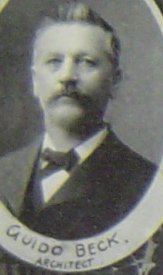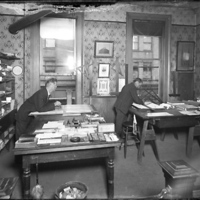Encyclopedia Dubuque
"Encyclopedia Dubuque is the online authority for all things Dubuque, written by the people who know the city best.”
Marshall Cohen—researcher and producer, CNN
Affiliated with the Local History Network of the State Historical Society of Iowa, and the Iowa Museum Association.
GUIDO BECK-1095 LANGWORTHY
ANCESTRY.com--https://www.ancestry.com/family-tree/pt/RequestTreeAccess.aspx?tid=178212434&pid=162316659188
BECK, Guido. (Tafertsweiler Ober Amt, Sigmaringen, Province of Hohenzollern, Germany, Jan. 25, 1853-Dubuque, IA, June 20, 1936). After attending school in Tafertsweiler until fourteen years old, Beck journeyed to the city of Sigmaringen. He learned the stonecutter's trade and attended the technical schools for three years. At Stuttgart, he cut stone for about a year, after which he spent a year in the Royal Technical High School. He was then sent to Heidelburg to direct the building of the waterworks during the next two years.
Beck returned to Stuttgart and became a soldier of the German army for three years, after which he re-entered the Technical High School, and he was graduated with honors and medals and a certificate as architect. Although the youngest of many who applied for the position of superintendent, he was given the contract by the German government to construct an asylum at Schussenried. This was later considered one of the finest institutions of its kind in Germany. Mr. Beck completed the work on this building in 1882, and then, against the wishes and advice of all his friends, left for America.
Beck worked as a stone-cutter in the government arsenal at Rock Island, Illinois. With the knowledge he already possessed, he became one of the foremost men of his line in the entire Northwest. (1)
In 1885 he came to Dubuque and worked for a year with Fridolin HEER before opening his own architectural business. He remained on his own for two years before joining Fridolin Joseph HEER, Jr. in the firm of BECK AND HEER which continued in business.
Beck designed over two hundred buildings varying in size from comparatively small ones to cathedrals. He was granted the contract for building St. Joseph College's chapel and auditorium and drew the plans for the West Hill (ST. COLUMBKILLE CATHOLIC CHURCH), ST. PAUL EVANGELICAL LUTHERAN CHURCH, and ST. ANTHONY'S CHURCH. (2) He also designed SACRED HEART CHURCH, HOLY GHOST CATHOLIC CHURCH, and the mortuary chapel at ST. RAPHAEL'S CATHEDRAL. (3) Beck designed schools including St. Patrick's and St. Raphael's in Dubuque. (3) In eastern Iowa he designed St. Mary's Church in McGregor and St. Joseph's in Elkader. (4) Between 1892 to 1895 he worked in a partnership with Martin HEER. (5) In 1899 Beck designed an addition to the west side of the house used by the Sisters of Saint Francis as a boarding house for young women.
---
Sources:
1. Jacobson, James E. "Key Dubuque Architects, Builders and Property Developers," The Architectural And Historical Resources of Dubuque, Iowa, 1837-1955, June 24, 2003, p. 154
2. London, Michelle, "Midwest Masters," Telegraph Herald, August 7, 2021, p. 7A
3. "Beck Funeral Rites Tuesday, " Telegraph Herald, June 22, 1926. p. 1. http://news.google.com/newspapers?id=1dBBAAAAIBAJ&sjid=-KkMAAAAIBAJ&pg=4090%2C5209768
4. Ibid.
5. Sayre, Robert F. Next Exit: New Views of the Iowa Landscape. p. 161 books.google.com/books?isbn=1587295555
5. Jacobson., p. 158
Portrait and Biographical Record of Dubuque, Jones and Clayton Counties, Iowa. Chicago: Chapman Publishing Company, 1894, p. 532
Goodspeed, Weston Arthur, History of Dubuque County, Iowa. Chicago: Goodspeed Historical Association, 1911, p. 651




